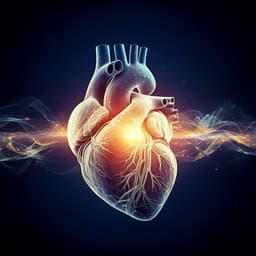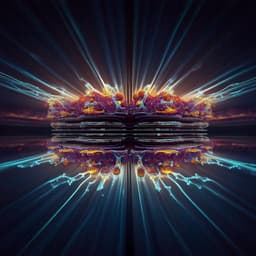
Physics
Artificial intelligence enhanced two-dimensional nanoscale nuclear magnetic resonance spectroscopy
X. Kong, L. Zhou, et al.
Discover how a revolutionary method combining deep learning and sparse matrix completion enhances nanoscale NMR spectroscopy. This research, conducted by Xi Kong and colleagues, not only improves signal sensitivity by an impressive 5.7 dB but also tackles the challenges of data acquisition in molecular structure determination.
~3 min • Beginner • English
Introduction
The study addresses the challenge of performing efficient two-dimensional nanoscale NMR using nitrogen-vacancy (NV) centers in diamond for molecular structure determination at the single-molecule or nanoscale level. Conventional NMR requires large ensembles to achieve sufficient SNR, losing single-molecule information. While NV-based nanoscale NMR has achieved single-spin sensitivity and microscopic 2D NMR, 2D acquisitions scale quadratically with sampling, making them time-consuming. The research question is how to significantly accelerate 2D nanoscale NMR data acquisition and reconstruction while maintaining high fidelity and robustness. The purpose is to develop a method that reconstructs full-resolution 2D NV NMR spectra from sparsely sampled data, improving SNR and reducing acquisition time. This is important for enabling practical, sensitive, non-destructive structural analysis under ambient conditions, pushing towards single-molecule structural elucidation.
Literature Review
Prior approaches to accelerate NMR include compressive sensing and sparse approximation in both conventional and nanoscale settings, but they rely on strong priors and may underperform at very low sampling ratios. Deep learning has shown strong capabilities in image super-resolution, denoising, and inpainting, and has been applied in physics problems such as noise mitigation in nano-NMR and state recognition in quantum devices. However, using simulated data for training introduces domain shift between simulation and experiment, and typical DL alone may not capture the global low-rank structure of NV NMR spectra. Matrix completion methods, particularly singular value thresholding (SVT), are effective for recovering low-rank matrices from incomplete observations. Inspired by domain adaptation and unobserved-entry fill strategies, the authors propose combining DL with MC to leverage DL’s nonlinear pattern recognition while enforcing low-rank structure to mitigate domain shift.
Methodology
Overview: The authors propose a combined deep learning plus matrix completion (DLMC) pipeline to reconstruct full-resolution 2D NV NMR spectra from sparse measurements. Step 1 uses a trained deep convolutional encoder-decoder network (DLNet) to infer a full map from partial data. Step 2 applies singular value thresholding (SVT) matrix completion to the DL output to enforce low rank and reduce domain shift.
DLNet architecture and training: The network is an encoder–decoder CNN with skip connections. The encoder has six groups of convolutional layers with residual (Res) blocks and learnable pooling (2x2 stride 2). Kernel size is 3x3 (stride 1, padding 1). Channel counts progress as: 32 (group 1), 32 (group 2), then doubling through groups 3–5 up to 512 (group 6). The decoder has five groups, each (except the last) with a transposed convolution (2x2, stride 2) followed by a Res block, halving channels stepwise back down to 32, with a final convolution to produce the reconstructed spectrum. Skip connections link encoder and decoder layers at matching resolutions to preserve detail and stabilize training.
Training data and procedure: Since experimental full-resolution spectra are scarce, training uses simulated 2D NV spectra. Original simulated maps are 50×50, zero-padded to 64×64, normalized to [0,1], and corrupted with Gaussian noise (mean 0, std 0.1). Inputs are the sparsely sampled map concatenated with its sampling mask along the channel dimension. The model outputs a full-resolution reconstruction. Loss: L1; Optimizer: Adam with learning rate 5×10^-4; Training for 500 epochs.
Matrix completion post-processing (SVT): To address domain shift and enforce low-rank structure, the DL output DL(M) undergoes SVT. Given partial observations M with known indices Ω, the algorithm iteratively performs SVD on the current iterate, thresholds singular values by τ, updates X via soft-thresholding, and corrects observed entries using step size σ, stopping when the relative reconstruction error on observed entries ||P_Ω(M−X)||_F/||P_Ω(M)||_F ≤ ε. Parameters include τ (singular value threshold), ε (tolerance), and σ (step size). The initialization X^(0)=Y^(0)=DLNet(M).
Experimental setup (nanoscale 2D NV NMR): A single NV center in CVD diamond (natural abundance 1.1% 13C) senses a coupled nuclear spin dimer under a 158 mT (≈1580 G) magnetic field aligned with the NV axis (13C Larmor ≈1.69 MHz). A COSY-like control sequence is used: initialize nuclear spins to the transverse plane via NV-assisted control, free evolution t1, effective π/2 on nuclear spins (realized via periodic NV π pulses; interval τ=292 ns), then free evolution t2, followed by correlation readout via NV. During initialization, NV is prepared with a 1.5 μs laser to ms=0, a half-π microwave rotates to the xy-plane, and a periodic π-pulse train with τ=7/(2ω_nuc) (τ=2045 ns, N=40) correlates nuclear and NV states, finalized by a π/2 pulse. Readout mirrors initialization with an added laser pulse.
Data acquisition: t1 and t2 are swept from 4 μs to 0.9 ms with 18 μs steps, yielding a 50×50 time-domain matrix; due to time cost, only 80% of entries are acquired. Each entry averages 1.5×10^5 readouts. Data are normalized to [0,1]. Random sampling masks at varying coverages (e.g., 40%, 10%) are used for tests.
Simulation for training and evaluation: Simulations solve the Schrödinger equation for the NV–nuclear system with Hamiltonians including NV–nuclear hyperfine interactions (S·A·I) and nuclear–nuclear dipolar couplings (I·J·I). Sequences mirror the experimental protocol; the ms=0 population is extracted as output. Additional simulations on multi-nuclear systems (e.g., five 13C spins in amino acids near NV at 1500 G; sampling rate 0.85 MHz; 500 points) are used to test scalability.
Inference pipeline: For a partially sampled experimental map: (1) DLNet reconstructs a full-resolution spectrum map DL(M); (2) SVT-based MC post-processes DL(M) to produce the final reconstruction DLMC(M), reducing bias and enforcing low rank. Reconstructions are analyzed in the frequency domain via FFT for SNR and RMSE metrics.
Metrics and analysis: Performance is quantified by SNR (peak maxima at [21.9, 21.9], [23.5, 21.9], [21.9, 23.5], [23.5, 23.5] kHz versus noise in blank regions), RMSE between original and reconstructed spectra, and SSIM to assess structural fidelity. Robustness is evaluated across five random sampling masks at fixed 10% coverage.
Key Findings
- DLMC significantly improves reconstruction quality at low sampling: at 10% sampling, DLMC successfully recovers the spectrum where MC-only fails; DLMC at 10% outperforms MC-only at 40% based on residual analysis.
- SNR improvement: Compared to FFT of the original data, DLMC enhances SNR by 5.7 ± 1.3 dB; MC-only yields 3.2 ± 3.1 dB. DL-only performed similarly to DLMC in SNR but lacked the low-rank enforcement; overall DLMC had the best combined performance.
- RMSE: DLMC achieves the lowest RMSE across sampling coverages (10–80%), indicating the best overall fidelity to the original spectrum.
- Robustness: At 10% sampling with five random masks, DLMC (and DL-only) shows smaller variance in SNR and RMSE than MC-only, indicating higher robustness to sampling pattern variations.
- Structural fidelity: SSIM is improved by DLMC across sampling coverages, signifying better preservation of structural content compared to under-sampled inputs and other baselines.
- Sensitivity impact: Maintaining SNR and RMSE from 80% down to 10% sampling implies enhanced bond-length sensitivity from ~0.8 nm/√Hz to ~0.3 nm/√Hz.
- Scalability: In multi-nuclear simulations (five 13C spins), DLMC reconstructs spectra from 10% random samples with RMSE 0.018 ± 0.002 (simulation without experimental noise), suggesting feasibility for more complex systems.
Discussion
The findings demonstrate that combining a simulation-trained CNN with SVT-based matrix completion effectively addresses two central challenges in nanoscale 2D NV NMR: acquisition time and reconstruction quality. DLNet leverages learned non-linear spectral patterns to inpaint missing entries from sparse measurements, while the MC post-processing enforces a low-rank prior characteristic of NV spectra and mitigates domain shift between simulated training data and experimental distributions. This synergy enables accurate reconstructions at sampling coverages as low as 10%, drastically reducing experimental time while improving SNR and fidelity over traditional MC alone and simple interpolation. The improved robustness across sampling masks and enhanced SSIM indicate that the method preserves spectral structures, which is critical for extracting coupling information and distances in molecular structure analysis. The approach generalizes to spectra with multiple peaks and, given that MC is agnostic to specific peak counts, is scalable. Incorporating additional loss terms (e.g., SSIM) and optimizing sampling schemes jointly with the network can further improve performance. The method’s generality suggests applicability to broader magnetic resonance and imaging modalities where low-rank structures and sparse sampling are prevalent.
Conclusion
The study demonstrates an AI-enhanced nanoscale 2D NV NMR protocol (DLMC) that reconstructs full-resolution spectra from as little as 10% of the data, yielding an order-of-magnitude reduction in acquisition time. The method improves SNR by 5.7 ± 1.3 dB relative to FFT of original data, achieves the lowest RMSE among compared methods, and remains robust under varying sampling masks. By combining deep learning with matrix completion, the approach intrinsically suppresses noise, mitigates domain shift, and enforces low-rank structure, thereby improving sensitivity (bond-length sensitivity from ~0.8 to ~0.3 nm/√Hz). The technique is extensible to spectra with multiple peaks and, in principle, to other MR and imaging applications. Future directions include integrating structural similarity metrics (SSIM) in training, co-optimizing sampling patterns with reconstruction networks, incorporating conventional signal processing (e.g., filtering, GFT), and applying the accelerated 2D protocol to assemble sufficient constraints for full 3D molecular structure determination.
Limitations
- Domain shift: DLNet is trained on simulated data due to limited experimental datasets, leading to potential biases. The MC step alleviates but does not fully eliminate domain shift.
- Artifacts and amplitude distortion: Visible artifacts and distortions persist in reconstructions at very low sampling ratios; current loss functions may not fully preserve structural content.
- Limited experimental sampling: Only 80% of the 50×50 time-domain grid was acquired due to experimental time constraints, limiting ground truth completeness.
- Generalization scope: While multi-spin simulations indicate scalability, experimental validation on more complex, multi-peak systems remains to be demonstrated extensively.
- Parameter sensitivity: SVT requires choosing thresholds and step sizes; performance can depend on these hyperparameters and sampling patterns.
Related Publications
Explore these studies to deepen your understanding of the subject.







